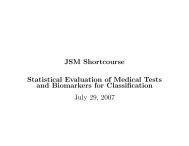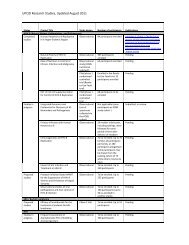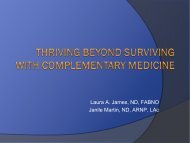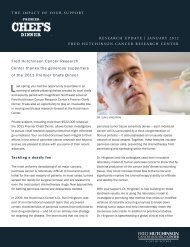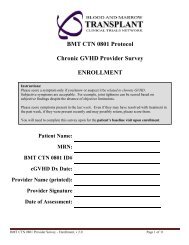Summer Undergraduate Research Program - Fred Hutchinson ...
Summer Undergraduate Research Program - Fred Hutchinson ...
Summer Undergraduate Research Program - Fred Hutchinson ...
You also want an ePaper? Increase the reach of your titles
YUMPU automatically turns print PDFs into web optimized ePapers that Google loves.
Presenting your Poster<br />
The Basics<br />
Presenting a poster involves a lot of talking . Viewers are often<br />
more interested in hearing you explain the research<br />
as opposed to reading the content of your poster<br />
themselves. You should be able to explain the research and<br />
any relevant details in five minutes or less to anyone who stops<br />
by .<br />
Remember that you are the expert and that people with more<br />
experience will be asking questions, not to test you, but out of<br />
genuine interest . It is important to know the project so that you<br />
can field questions without losing confidence. Experienced poster<br />
presenters know their work inside and out, forward and backward .<br />
Be aware that you will be approached by experts in your field<br />
as well as those that are just curious about the research . To<br />
accommodate both the expert and the layman, a good rule of<br />
thumb is to prepare two talks . You should prepare a twominute<br />
summary for people who seem interested in your<br />
research, as well as a more detailed version . Start with the short presentation and expand if the viewer(s)<br />
starts asking questions. It’s very important that you be able to explain every part of your data, figures,<br />
graphs, research, or results .<br />
Deliver your message quickly!<br />
The best presentations make just one point, loudly and clearly . You might have tested two or three<br />
closely related hypotheses, but they should all revolve around the same single point . To deliver just one<br />
point, do your best to develop a summary of your work that you can state in 25 words or less .<br />
Once you know the central message, you need to decide what supporting information to present . The best<br />
presentations generally follow the guidelines of a published paper, and include the following sections:<br />
Introduction, Materials and Methods, Results, Summary/Conclusions and Discussion/Future <strong>Research</strong> .<br />
Determine the central message for each section of your poster in your presentation .<br />
What is the central message of your Introduction? This section should start with your general research<br />
objectives, then provide a few lines about the context of your work, and end with a clear statement of the<br />
hypotheses or predictions that you tested .<br />
What is the central message of your Methods? Provide the bare essentials with regard to the subjects,<br />
study site, and protocol. Don’t be so brief that the viewer can’t figure out what you did, but do give some<br />
thought as to what is really relevant to this particular talk . If some facet of your research is peripheral, leave<br />
it out .<br />
What is the central message of your Results? What did you discover? Did your tests come out the way you<br />
expected?<br />
What is the central message of your Summary/Conclusions and Discussion/Future <strong>Research</strong>? This is<br />
where you deliver the take-home message. Again, in 25 words or less, what is the dramatic finding that you<br />
want your audience to remember? And why should they care? This is very important, because viewers want<br />
to know what you did and why it is significant.<br />
115




